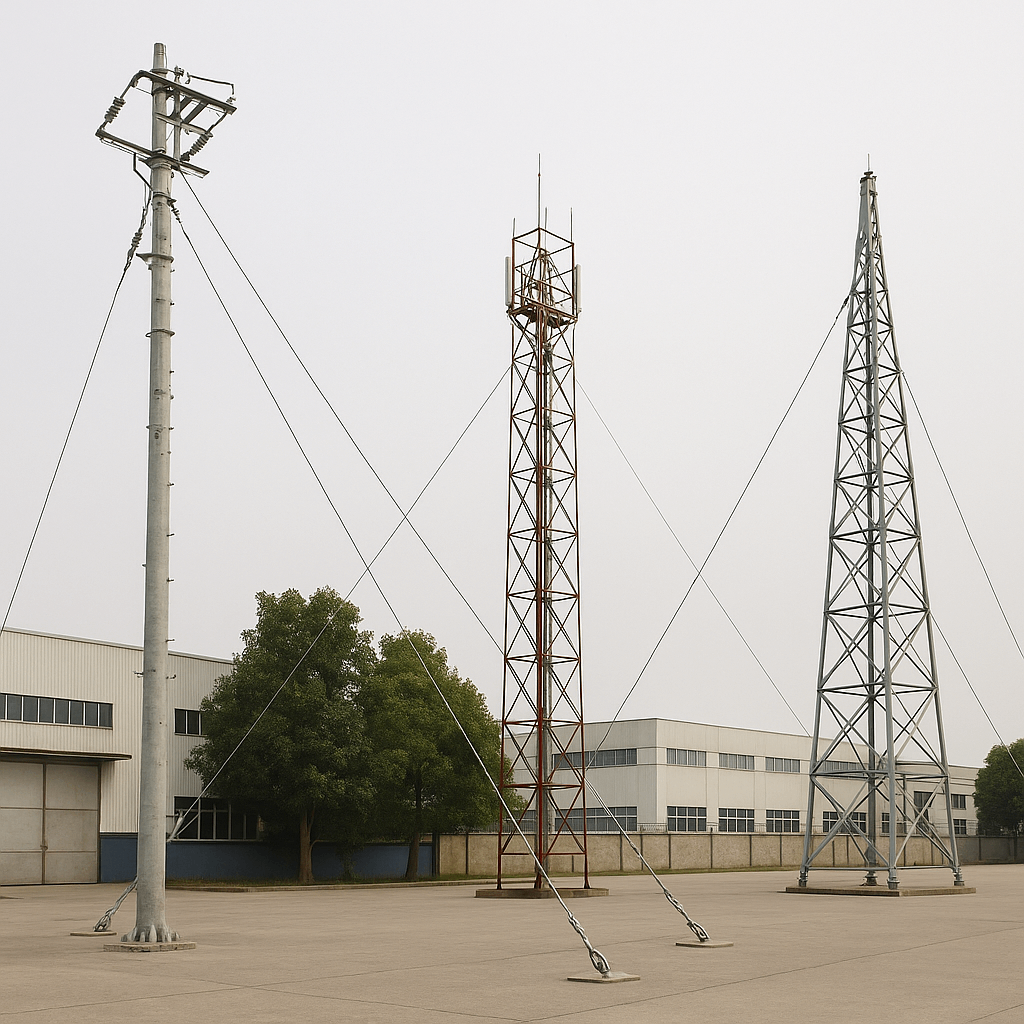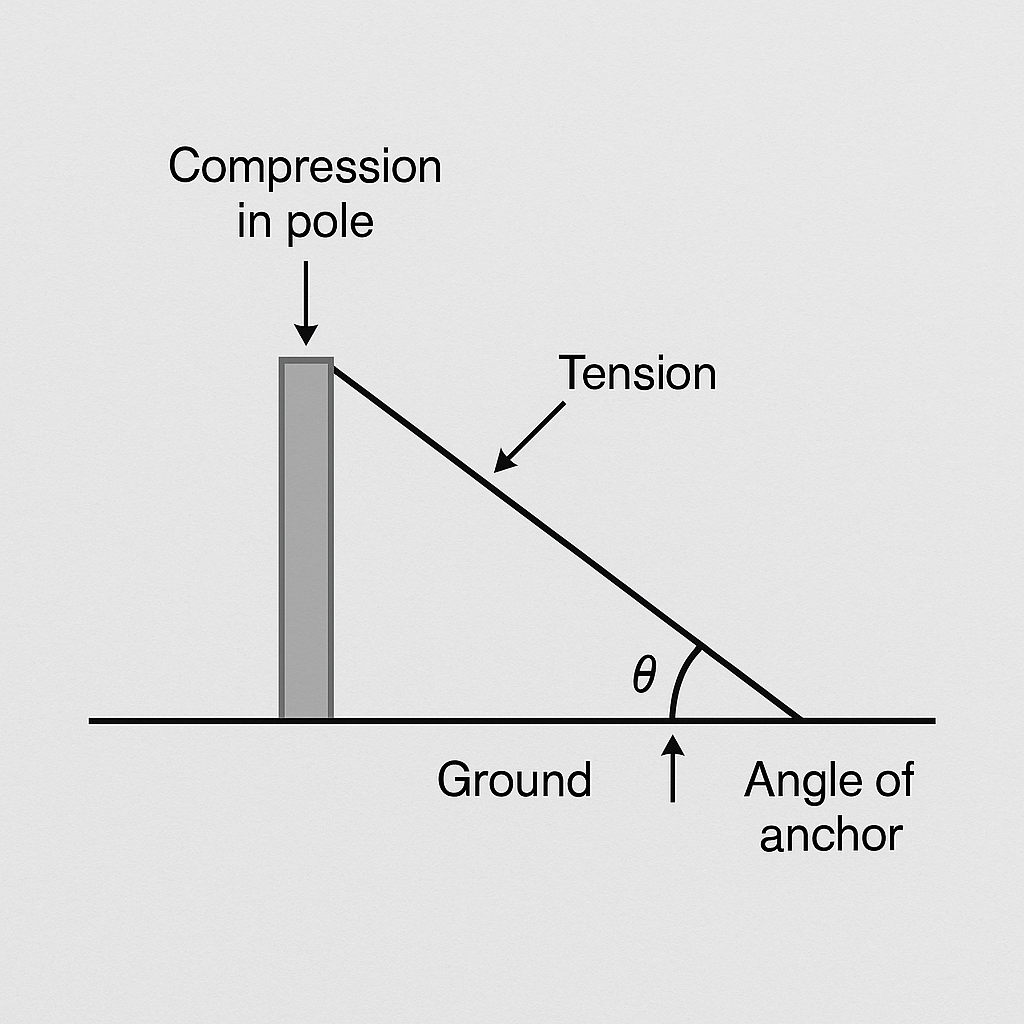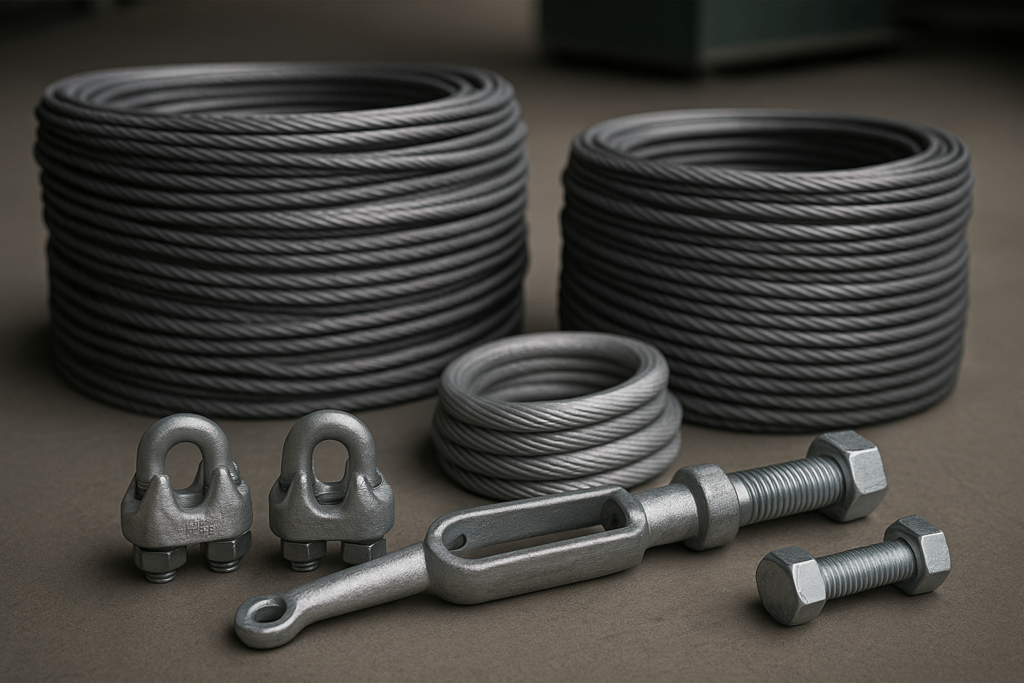Stability Behind the Steel
Whether it’s a 50-meter communication mast or a high-voltage distribution pole, many vertical structures rely not just on materials, but on engineered tension systems. Guy wires—used widely in industrial applications—play a quiet yet decisive role in preventing lateral failure.
This article provides industrial buyers, engineers, and project managers with a clear, in-depth understanding of guy wire systems. We’ll cover how they function, how to specify them, and how to ensure long-term performance. The content is designed for those evaluating suppliers, selecting system specs, or overseeing infrastructure deployment.
What Are Guy Wires – And What They Are Not
In industrial settings, a guy wire (or stay wire) refers to a high-tensile cable designed to support vertical structures under lateral load. They act purely in tension—anchored into the ground and affixed to poles, towers, antennas, or frames.
These are not conductive wires. Mistaking them for live cables is common in non-engineered settings. They are engineered components with specific preload tension, anchor depth, and angular orientation. Their strength is dictated by material grade—typically EHS galvanized steel—and by configuration.
In different sectors, alternative names exist: tension cable, support cable, or tower anchor line. Regardless of label, what matters to purchasers is ensuring that the selected system meets the required wind zone, height, and fatigue cycle expectations.
Functional Mechanics: Load Resolution and Design Influence
In structural terms, guy wires resolve lateral load into ground-anchored tension. Their primary job is to reduce bending moments at the base of the structure by pulling it backward or sideways in response to force from wind or equipment.
Proper design includes choosing the correct anchoring angle. Lower angles offer better lateral resistance but require more ground space. High-angle installs are space-efficient but mechanically less robust under crosswind. Engineers use trigonometric modeling to identify the most effective guying angles and tensions for different load cases.
For tall towers, guy wires are placed at multiple elevations, each calibrated for unique wind loading patterns. In certain cases, damping mechanisms are used to reduce oscillation frequency. These are critical for towers in typhoon or hurricane zones.
System Anatomy: Components and Industrial Materials
Each guy wire system involves a coordinated set of components:
High-tensile steel rope (e.g., 3/8″ EHS galvanized)
Anchor system (driven rods, helical piles, or deadmen blocks)
Tension adjustment hardware (turnbuckles or clevis rods)
End protection parts (thimbles, cable clamps, locking devices)
Durability is key in long-term infrastructure. For example, 0.01 mm wire filaments used in CNC EDM wire cut technology offer minimal elongation—ideal where micro-precision is required. For field-scale guying, the focus shifts to galvanized cable systems tested under ASTM A475 and equivalent ISO standards.
Table: Key Materials and Roles
| Component | Common Material | Function |
|---|---|---|
| Main Wire | EHS Galvanized Steel | Tension member |
| Anchor System | Steel / Concrete | Transfers lateral force into ground |
| Turnbuckle | HDG or Stainless Steel | Field-adjustable tension calibration |
| Clamp & Thimble | Hot-forged Galvanized Steel | Protection against wear & slip failure |
Industrial Applications and Engineering Variants
Guy wire installation for high wind zones is a growing priority in both telecom and energy infrastructure projects. In coastal or typhoon-prone environments, anchoring depth and wire preload are engineered with increased safety factors to withstand gust-induced oscillations. Selecting a system tailored for such high-exposure environments is crucial to ensure long-term reliability and structural compliance.
Guy wire systems differ by industry. A key procurement consideration is whether the application requires permanent, semi-permanent, or rapid-deploy installation.
Telecom: Towers from 30 to 100 meters tall use multi-level guying. Anchor loads often exceed 5,000 N. Site planning must consider 3× tower height for anchor footprint.
Utilities: Stay wire systems for utility poles vary by terrain. Corner poles in hilly zones demand diagonal guying plus soil-stable anchors.
Greenhouse & Agriculture: Tensioned frame supports protect from seasonal wind shear. Lightweight, shallow-anchor systems reduce soil compaction.
Wind Energy: Guy wire for wind turbine support ensures mast stability in off-grid and mobile installations.
Comparative Engineering Table
| Application | Anchor Depth | Tension Range (N) | Anchor Type | Design Life (years) |
| Telecom Mast | 1.8–2.5m | 6000–10000 | Helical + Concrete | 20–30 |
| Utility Pole | 0.8–1.2m | 3000–5000 | Rod + Deadman | 15–25 |
| Agri Frame | 0.5–0.9m | 1500–3000 | Helical (solo) | 5–10 |
| Wind Turbine Mast | 1.5–2.0m | 5000–9000 | Multi-anchor | 10–20 |
Common Questions from Buyers
Q: Is there a stay wire tension calculator I can use for project pre-evaluation?
Several engineering platforms offer downloadable calculators for initial tension-load estimations. These tools allow you to input structure height, wind zone, and cable angle to simulate system demand. However, they should supplement—not replace—professional structural design.
Q: Is thicker always better?
Not necessarily. EHS cable in smaller diameters often outperforms mild steel in larger ones. When comparing EHS wire vs stainless steel wire, EHS typically offers higher tensile strength per dollar for static loads, while stainless steel excels in corrosive environments or where aesthetics are required. Focus on tensile strength, not size alone.
Q: Helical vs. driven anchors?
Helical systems allow controlled depth installation and are ideal in soft or sandy soils. Driven rods offer speed but may not hold in wet clay.
Q: Can I use CNC EDM wire cut cables for structural guying?
No—such microfilament wire is for machining, not tensile systems. The terminology overlap causes confusion but not interchangeability.
Q: Can I buy guy wires in bulk for multi-site deployment?
Yes. Bulk procurement is cost-effective for contractors managing tower installation across multiple regions. Ensure packaging matches site specifications.
Selection Parameters: How to Specify the Right System
Every procurement process should start with quantifiable load assumptions. Key inputs include:
Maximum wind pressure (Pa)
Structure height and weight
Soil class or bearing strength (kPa)
Safety factor (typically 2.5–5)
Selection isn’t just about diameter. It’s about total system performance—fatigue resistance, installation feasibility, and post-tension adjustability.
Table: Quick Reference Guide
| Structure Height | Wind Zone (km/h) | Wire Size (inch) | Preload Tension (N) | Anchor Type |
| <15 m | <100 | 1/4″ | 1500–2000 | Driven Rod |
| 15–30 m | 100–120 | 3/8″ | 3000–4000 | Helical Anchor |
| 30–50 m | 120–140 | 7/16″ | 5000–7000 | Helical + Concrete |
| 50 m+ | >140 | 1/2″+ | 8000–10000+ | Rock / Multi-Anchor |
Maintenance Standards and Inspection Protocols
Routine inspection is not optional in critical structures. Buyers should verify whether their supplier provides guidance on:
Seasonal retensioning plans
Corrosion mitigation methods
Ground anchor verification tools (e.g., pull tests)
OSHA standards require guy guards in pedestrian zones. ANSI C2 regulates safe angles and clearance heights. These aren’t just legal standards—they influence insurance eligibility and system lifespan.
Forward Thinking: Smart Systems and Future Design
Emerging technologies include:
Sensor-embedded guy wires for real-time tension alerts
Carbon fiber stay wires for mobile or lightweight towers
AI-based lifecycle analytics, especially in coastal or seismic zones
Tension cable for mobile towers where rapid deployment is required
These advancements reduce emergency failures and help align long-term maintenance budgets with operational realities.
Final Thoughts
Industrial buyers aren’t just purchasing a cable—they’re managing liability, compliance, and uptime. Investing in correctly specified guy wire systems reduces downtime, supports safety audits, and preserves structural alignment across decades.
YISHANG has supported global clients across infrastructure, utility, agri-tech, telecom, and renewable energy sectors with custom guying systems manufactured under ISO 9001 protocols.
As an ISO certified guy wire manufacturer, YISHANG aligns product validation and traceability with global standards to support international tendering and export compliance.
Contact us to discuss your design parameters.



